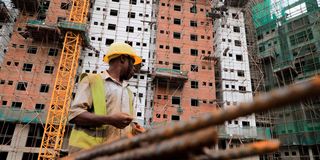Premium
Will affordable housing dream come true this time round?

An aerial shot of government Affordable housing project in Ngara, Nairobi in this photo taken on December 25, 2021.
What you need to know:
- According to the National Housing Corporation, about 2 million units are needed to fill the housing deficit in the country.
- The available homes are mostly owned by high and middle-income earners, with low-income earners residing mostly in informal settlements.
- Low-income earners are often locked out of accessing housing through avenues such as mortgages due to the strict requirements most plans have, including collateral in the form of land, or formal employment and a certain pay grade.
It is the dream of every Kenyan to own a place they can call home. But with the price of construction materials and land constantly rising, it is becoming very difficult for many to achieve this dream.
According to the National Housing Corporation, about 2 million units are needed to fill the housing deficit in the country.
The available homes are mostly owned by high and middle-income earners, with low-income earners residing mostly in informal settlements.
Low-income earners are often locked out of accessing housing through avenues such as mortgages due to the strict requirements most plans have, including collateral in the form of land, or formal employment and a certain pay grade.
Generally, there are also few funds available for housing projects. Most real estate developers rely on banks for funding, but these also come with high collateral requirements as banks view the real estate sector as high risk due to a historically high number of loan defaults.
Development of houses has also become difficult due to market disruptions such as the war in Ukraine and the Covid-19 pandemic, which have resulted in a sharp increase in prices of key construction materials such as cement and steel.
The price of land for development has also sharply risen over the years. In some satellite towns, prices have gone up by up to 6 per cent.
In upmarket areas such as Kilimani, this has gone even higher due to market disruptions coming in from new players such as foreign nationals.
As a result, against an annual demand of 250, 000 units, a report by the Kenya Property Developers Association reveals that only about 50, 000 units are constructed every year.
Affordable Housing project
To fill this gap, President William Ruto has promised to construct about 200,000 housing units per year, under the Affordable Housing project, launched by his predecessor Uhuru Kenyatta in 2017.
Kenyatta’s administration had set a target of delivering 500, 000 units by December 2022, but this was not realised.
This then begs the question, how viable is President Ruto’s ambition to deliver hundreds of thousands more houses within the given timeline?

President William Ruto operates an excavator machine as he launched the Soweto East Zone B social housing programme in Kibera on October 25, 2022. The project will comprise 4000 houses.
Simon Malonza, an architect whose firm has undertaken affordable housing works in the Pangani and Jeevanji areas, notes that it is possible to realise the affordable housing dream, but so many factors need to be straightened out first.
There is a lot of mismatch between what the government wants to achieve, and what the reality on the ground is.
For example, he says that owners of capital, such as banks, are not flexible or moving in tandem with the current business environment, noting that banks need to adjust their policy framework to align with that of the real estate market.
He also notes that pension schemes need to diversify their investment portfolios to have more resources available at their disposal.
“Nearly all pension schemes have invested in things like treasury bills and bonds, which, however, take longer to mature. So, a pensioner will invest their money in a scheme to get a house, but because the investment has not matured, they will not get what they need,” notes Malonza.
He adds that the government could also come up with legislation that will make other investment vehicles such as Real Estate Investment Trusts (REITS), infrastructure bonds and asset-backed securities more attractive to these pension schemes and to other investors.
This will free up more capital for the development of houses. Currently, most of these investment vehicles attract low-interest rates that are not attractive to investors.
Malonza also notes that there is a need to lower the cost of construction materials. This can be achieved by imposing subsidies or tax incentives on some of the construction materials and house fittings.
“Most of the construction materials we use are imported, so cushioning ourselves against external shocks can be difficult. But with concerted effort between the government and manufacturers, we can have doors made locally, Jua Kalis can produce the quality of tools that we would want, this way, we can set our own prices,” he notes.
He adds that embracing new and alternative building materials and designs could also go a long way in lowering the cost of construction. Using these innovative materials, which may include prefabricated blocks and slabs, advanced adhesives or roofing materials, could also fast-track the construction process.
Indeed, with new construction technologies, houses can even be prefabricated in factories and assembled on-site.
Though these technologies might be costly at the onset, they help reduce construction time and labour required on-site and are therefore cheaper in the long run. They also help to reduce the amount of carbon footprint left behind.
He also points out that there is a need to streamline the approval and certification processes, because there is a huge mismatch between land certifications and the construction process, with delays in approvals frustrating both buyers and developers.
“You can finish up your house in two years, but it will take you a year to get the necessary certificates, such as title deed and Nema approvals. While we appreciate the need for these approvals, why should it take that long to get certificates?”
Collaboration
Daniel Ojijo, a developer, is of the opinion that affordable housing can be realised by creating a more dynamic and robust partnership between the government and private developers.
“The affordable housing dream began with the private sector, but it was only going to work if the government took the driver’s seat, so we are happy that the government has come in with a lot of passion.
Just recently, president Ruto flagged off about 5, 000 units in Mukuru Kwa Njenga and several more will be done across different parts of the country. Tenants will own these units through monthly rental payments,” notes Ojijo.

Daniel Ojijo, a developer, is of the opinion that affordable housing can be realised by creating a more dynamic and robust partnership between the government and private developers.
He, however, notes that as it is, there is still some ineffectiveness in this partnership. This is brought about by a number of factors, such as a lack of clarity on returns and revenue sharing.
There is also limited budgetary support coming in from the government to private developers. Ojijo says the government should provide more cash incentives for those developers that are doing low-cost housing.
For example, they could provide an alternative funding facility which the developers can tap into, that offers affordable loans of around 8-9 per cent interest so that the cost of development is brought as low as possible.
“For low-cost housing, the cost for the developer is very important. That one simple element can turn your profit into a deficit, so every cost a developer can save is paramount to increasing their markup. Looking at it from this business perspective will even encourage more private developers to come on board,” notes Ojijo.
The developer notes that it is good that the government has given financial thought to the consumer through incentives given by the Kenya Mortgage Refinance Company, (KMRC), but adds that it is also good to look at the supply side.
“We want to encourage local private developers to come on board and do these houses. We do not want to see a situation where only foreign developers are doing these projects because of the cost of production. The low-cost housing agenda is also about empowerment, and we need to build the capacity from within,” notes Ojijo.
He adds that there is also a need to lower the cost of mortgages. Indeed, in other countries, mortgage rates are as low as 3 per cent.
This makes it economically viable for someone looking to buy a house to do so, as the monthly rent they pay is almost equivalent to the mortgage rate paid.
“Kenya Mortgage Refinance Company should be very strict, such that when disbursing mortgages, they do not go beyond rates of 9 per cent. A lot of banks have already gotten the money, but they are still charging interest rates of between 13-14 per cent, so was the purpose of KMRC to fund the banks, or to ensure that the mortgage rates come down for the low-cost housing?” wonders Ojijo.

A worker at affordable housing units under construction at Pangani Redevelopment Site in this photo taken on January 21, 2022.
Access tenders
The government, he stresses, should also support private companies by developing policies that ensure even companies in the counties are able to access tenders.
This should be backed by addressing bureaucracy that interferes with procurement processes. As for private developers, they also need to be sensitised about why it is important to not only focus on their returns, but also on benefitting the public, as this will ensure they produce socially-conscious works, and on time.
His view is echoed by Effie Otieno, a real estate project development officer, who stresses that public-private partnerships if done correctly, will make it easier to realise the affordable housing goal.
“A case in point is the Pangani housing estate and Ngara, which have been actualised very fast. The private sector has the capability, the technology and the manpower, meanwhile, the government comes in with the incentives, and hastens the approval processes, making delivery easy,” notes Ms Otieno.
She adds that due to the high housing deficit in Kenya and the shortage of supply, realising the affordable housing goal is possible, however, there is also a need to address the availability of land for development.
Land in Kenya is very expensive, and developers in urban dwellings often have to battle with the high cost of land. Most of the cheaply available land is located in remote areas that are not serviced with infrastructure, therefore not economically viable.
“There are places you cannot build affordable homes. In an area such as Kileleshwa, the land is almost Sh300 million per acre, so, if you do about 200 units per acre, an individual will be paying around Sh1.5 million per unit, just enough for the developer to recover the money spent on land, so it becomes difficult to actualise affordable housing in the suburbs of Nairobi,” notes Ms Otieno.
While it is not easy to address the exorbitant land prices as they are mostly influenced by market forces, she notes that the government can support private sector players by addressing issues such as the availability of social infrastructure to make housing developments in these areas more economically viable.





